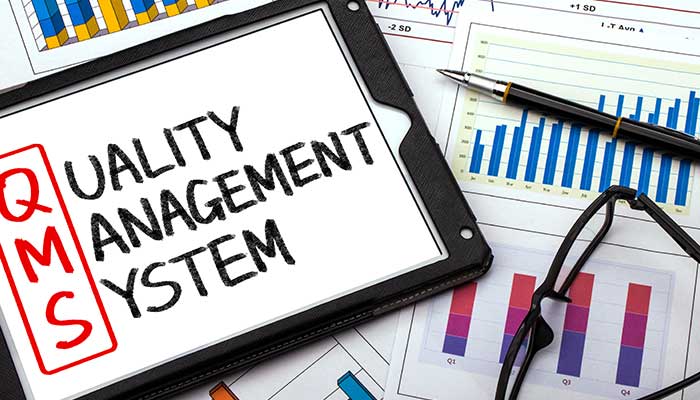A Quality Management System (QMS) is a set of coordinated activities to control an organization to continually improve the efficiency and effectiveness of its performance. QMS standards help in establishing a framework for a business to manage its key processes. Companies failing to embed an effective and automated QMS in their manufacturing weaken their competitive stand in the market. However, automating the quality processes, such as training, document control, risk management, and corrective action into one easy-to-access, easy-to-use effective QMS can give your organization the competitive edge that is needed to achieve compliance success. For these reasons, ISO 9001:2015, which is the international standard that specifies the QMS requirements, is the most prominent approach to QMS.
Benefits of QMS
With a quality management system, an organization is able to achieve the objectives and goals set out in its strategy and policy. It provides satisfaction and consistency in terms of materials, methods, and equipment, and also interacts with all activities of the organization, which starts with the identification of customer requirements and ends with customer satisfaction, at every transaction interface.
Some of the benefits of implementing an effective, automated QMS include:
- It saves a lot of time and reduces waste.
- It improves a company’s profitability as it lowers the costs.
- It accelerates compliance and reduces the risk of non-compliance.
- It enables the company to deliver safer and higher quality products to the customers.
- It improves the processes and engages staff.
- It facilitates and identifies training opportunities.
ISO 9001:2015 Quality Management Standards
The International Organization for Standardization (ISO) released a revised version of one of the most widely used and popular standards, ISO 9001:2008 QMS, in 2015. The most important revision is the switching up to compliance with Annex SL. Annex SL serves as a blueprint for Management System Standards (MSS) so that they can be combined and expanded upon while being compatible with each other without confusion. Compliance with Annex SL also molds the content of ISO 9001 and other related MSS regarding a common structure, terms, and definitions.
With ISO 9001:2015, quality management has entered the central business outlook by taking advantage of company focus, senior managers, leadership, and complete integration into business practices. This revision has also brought ISO 9001 up to relevancy regarding both challenges and opportunities arising from globalization, changing technologies, and a reinforcement of a risk based approach.
Key Requirements of ISO 9001:2015
- Under ISO 9001:2015, the organizations are required to integrate the QMS requirements into the business processes of the organization; and to understand the internal and external issues of the organization and expectations of all interested parties.
- Also, under the new standard, the organization is required to provide a program plan to achieve quality objectives, such as: who is responsible, what is the schedule, and what methods or techniques will be utilized to manage the program.
- The organizations upgrading to ISO 9001:2015 are also required to develop a process to address opportunities and risks. While many ISO practitioners and consultants refer to this requirement asrisk-based thinking, the requirement can be practically described as risk analysis.
- Several clauses of ISO 9001:2015 have inherited various levels of threats and risk to the organization by preventing them from meeting their improvement objectives and satisfying their customers’ needs.
- Changes in equipment or processes, employee work instructions, and raw materials are examples to the areas where the organization should start analyzing and provide planning for mitigating the risks before implementing the change.
- While scheduling internal audits, it is required that the organization should consider the risk level of errors that is presented by each process when establishing the frequency of audits.
- The addition to the ISO 9001:2015 version is Clause 7.1.6,Organizational Knowledge. Under this, the organizations, depending on their operations are required to have some formalized program for technology updating, succession planning, and supplier contingencies.
For more insights on the benefits of an effective QMS and the key requirements of ISO 9001:2015, attend this Webinar by expert speaker Louis M. Gobern, PMP, who is the President of Quality Business Management Solutions (QBMS), a training, consulting, and auditing company. You will also be able to gain a better understanding of both your organization’s obligations and your personal responsibilities.



